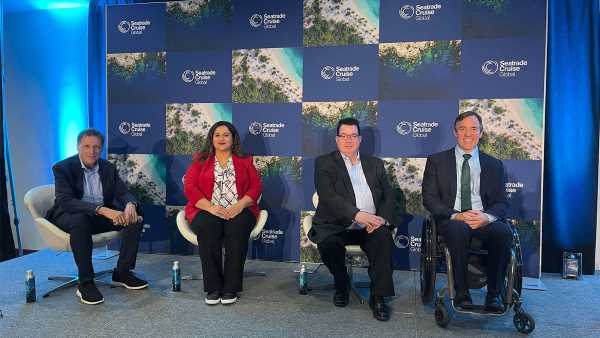
John Sage began with a statement: “I’ll begin by talking about what it feels like to have a disability. When I wake up in the morning, I get out of bed, feed my daughter breakfast and take her to school. And I don’t feel my disability.
“But when I travel and run into unexpected accessibility barriers, I start to feel disabled. It’s not my wheelchair that makes me feel disabled. It’s the barriers.”
Sage, CEO of Sage Traveling, was on a panel I moderated at the Seatrade Cruise Global conference in Fort Lauderdale this week that addressed “Building and Promoting Accessible Travel Experiences in Cruise, from Embarkation to Excursions.”
I asked Sage for an overview of how the cruise industry stacks up to land options in making travel accessible to people with disabilities.
The answer: Pretty well. And part of that has to do with lines’ ability to create a controlled environment.
“I have yet to see a cruise ship with cobblestones on it,” Sage said. “Cruise ships really have some built-in advantages versus land. Bathrooms tend to vary in accessibility across resorts and hotels but tend to be standardized on cruise ships.”
Since 2009, Sage’s company has worked to find accessibility solutions for travelers. And in 2016, he launched Accessible Travel Solutions (ATS), a tour division to offer accessible travel packages to advisors and shore excursions for cruise lines. Currently, 11 cruise lines use the service.
Also on stage were Henna Sheikh, operations manager for ATS, and Ron Pettit, Royal Caribbean Group’s director of disability, inclusion and Americans with Disabilities Act (ADA) compliance.
I asked Sheikh about the challenges of creating accessible shore excursions.
Cruisers with disabilities once had only two choices, she began: stay on the ship or take a panoramic motorcoach tour.
But now, even Rome — the City of Seven Hills, many etched with cobblestone streets — can be made accessible to travelers with disabilities on a full eight-hour excursion. “It required getting special permission for our vehicles to drop a guest in front of the Vatican Museum,” she said, “and to use a lift installed in the Sistine Chapel.”
Similarly, lifts help her guests visit the Colosseum when in Rome.
ATS often needs to work with port authority officials to get permissions to arrange to get guests off ships and piers. Working with cruise lines has been key, and their first cruise partner was Royal Caribbean Group.
Royal’s Pettit discussed how that company’s approach to accessibility evolved.
His team of 30 people are all focused on accessibility and ADA compliance. “Our approach begins with, how do we support our communities? Inclusion has many components. It’s about our employees. It’s about digital accessibility, making our websites and mobile applications accessible. It’s about supplier diversity, working with companies that are disability- or disability veteran-owned. We make our ships welcoming for families with a member who has autism; not just the people with autism, but their families, too.”
Royal’s focus on making information available through all channels — not just its call center and websites, but through travel partners and GDSs — is necessary to attract travelers with disabilities, Sage said.
“To book an accessible room or to rent a car with hand controls or to arrange disabled assistance to get onto an airplane involves extra steps,” he said. “Before I book, I want to feel really confident that I’m not going to encounter accessibility barriers. I tried to rent a car a couple of weeks ago and couldn’t book hand controls online. I had to search the website for a phone number. To book an accessible hotel in Puerto Rico last summer, I spent 36 minutes on the phone. It’s this tedious booking process that disabled travelers often have to go through; they don’t want to mess with it, which is why they stay home.”
Travel companies underestimate the amount of information that’s needed, Sage continued.
“The way to gain my trust is by publishing detailed accessibility information,” he said. “Disabled travelers universally understand how important that is, but when I talk to executives at travel companies, they do not. We need not just text, not just bullet points, but photographs and measurements.”
For the most part, Sage added, “cruise lines are doing a good job of this.”
The World Health Organization estimates that 15% of the global population has a disability. That number is actually higher, 20% to 25%, in the developed countries that are the target source markets for most travel companies, in part because people there are living longer. When it comes to seniors, those 65 or older, 50% are considered to have a disability.
Forty-six percent of baby boomers have already reached 65, and tens of millions will cross that threshold over the next decade. The traveler with a disability is no longer a niche, but travel companies that continue to ignore their needs risk becoming niche outliers, in the most negative sense.
Source: Read Full Article










